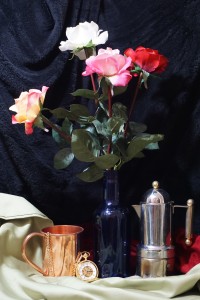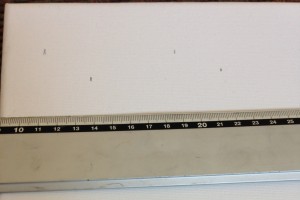|
|
 I have adopted this as my next big, slow project. It is a photo from twitter, by Zed Shaw, a programmer and artist. He taught himself to paint, and put the Learn Coding the Hard Way series into the world. I have adopted this as my next big, slow project. It is a photo from twitter, by Zed Shaw, a programmer and artist. He taught himself to paint, and put the Learn Coding the Hard Way series into the world.
Philosophical aside: Zed set up the still life to paint himself, and the photograph was striking enough that I asked him if I could. Our processes are likely to be entirely different, but they do share some similarities, so as I go through I will be observing what he does, and I will take notes here. While I was thinking about the methods that would be involved, it occurred to me that painting styles and schools probably had a lot in common with programming languages. There are different ways of getting an end result, entirely different philosophies as to how you should go about things, and elitism, and editor wars, and fine art vs illustrator divisions. Both things are almost like real life, in many respects.
The first thing I did was to sketch one of the roses. That is unusual, but I was really eager to start the project, and I had other work on. The second thing I did was to buy a decent size of canvas. This is going to be 36″ tall. It is 28″ wide, which is a little wider than the photograph. Zed’s photo is pretty closely cropped by his choices in the photography process, but the parts that have been cut off are only drapery. If I can’t fake a couple of inches of drapery, I’m a Dutchman. I’d be taller if I were, and I’d have better teeth.
 As I am working exclusively from a photograph, I gridded up the canvas. On my computer, that is a line every 500 pixels. On the canvas, it is 3 inches. That is a bit of a stretch, but the only part that worries me is the watch chain. Last time I did something like this, the band of a watch took me two quarter days. This one looks like it may be two half days, rather more like a woven cord than a metallic bracelet. As I am working exclusively from a photograph, I gridded up the canvas. On my computer, that is a line every 500 pixels. On the canvas, it is 3 inches. That is a bit of a stretch, but the only part that worries me is the watch chain. Last time I did something like this, the band of a watch took me two quarter days. This one looks like it may be two half days, rather more like a woven cord than a metallic bracelet.
On the right, you can see the offset of grid points. I messed about a little with positioning, and finally chose to have the work for which I have data set exactly in the middle of the canvas. The edges will be made up and the lies will have symmetry. I drew the dots onto the canvas, and looked at it until I was sure of where they actually had to be, and then I drew new dots. After that, I drew a big grid across the whole canvas, and started copying the photograph.
 I went carefully around patches that will be different colours on the finished painting. This will let me apply the first layer of colour quickly and relatively accurately. Some of the shapes are off, because I was drawing right-handed and the canvas was on its side. I should be able to deal with those as I get to them, but for the moment I have a finished non-tonal under-drawing. I now need to paint over that. The graphite will gunge up the paint, but it will also get sealed in by the oil, so the second layer will be clean and will have decent paint to work on. I will be painting two or three layers, at the very least, with lots of blending, and the darkness in the first will be lost in the general tone of the piece. I went carefully around patches that will be different colours on the finished painting. This will let me apply the first layer of colour quickly and relatively accurately. Some of the shapes are off, because I was drawing right-handed and the canvas was on its side. I should be able to deal with those as I get to them, but for the moment I have a finished non-tonal under-drawing. I now need to paint over that. The graphite will gunge up the paint, but it will also get sealed in by the oil, so the second layer will be clean and will have decent paint to work on. I will be painting two or three layers, at the very least, with lots of blending, and the darkness in the first will be lost in the general tone of the piece.
By the end of the day I had lost the light entirely, and I was drawing by the strip lights in the studio, so the last picture of the full work is not worth showing. I have it for posterity, and it will still be visible for a while, so instead here is a close-up of part of the jug, showing what will eventually be shine and reflection on a bronze surface.
|